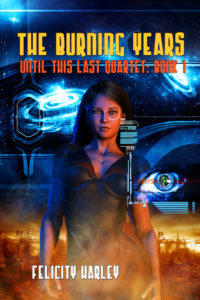Book Review: The Burning Years by Felicity Harley

Imagine a cackle of hyenas are chasing you towards the edge of a precipice. Do you stay and fight or do you take a leap into the unknown? In the slow motion of everyday life this might seem like an eccentric analogy to illustrate humanity’s impact on each other via climate change, but we all know time is relative. If we don’t get a handle on this most pressing of issues then it will get a handle on us, and it’ll all be over in the blink of an eye. To distant observers at least.
The Burning Years is a novel set in the mid- to latter twenty-first century, at a time when Earth has being badly scorched by the sun as a result of climate change and humans’ disastrous attempts to control the weather instead of looking after the environment. As a consequence of the negligence of successive generations, people are now having to move underground in order to survive the harsh new world their grandparents created for them. A plutocracy governs the United States, in much the same way as it does now (although many will disagree with me on that point).
A weather modification program set up by the plutocracy is dismantled by a scientist named Sophie who is then forced to go on the run. As if that wasn’t rebellious enough, Sophie also steals from the government two trans-humans (part-human, part technologically-advanced species that essentially possess some superhuman powers).
While millions survive in underground communities, millions more die as the story unfolds over decades. The question is: Can humanity survive long enough underground to see better days ahead, to a time when Earth might be able to begin to heal itself? Or would staying here be a bad idea? Readers get to see both scenarios; while Sophie flees the government, another scientist named Rachel leads a worldship dubbed Persephone to the nearby star Proxima Centauri just over four light years away.
I was particularly intrigued to see where Harley, a writer and journalist who bills this as the first of a four-part series, would go with the worldship because although this is fiction, Persephone is based not only on real science but a real-life project. (Likewise, the character Rachel is inspired by real-life revolutionary scientist Rachel Armstrong.) Persephone is a spaceship that will harness the forces of nature and be built from what’s termed “living architecture.” Using protocells (chemical agents that have lifelike behavior) the worldship will regenerate as biology, chemistry, and technology complement each other to keep the ship alive. The objective is to use this giant natural computer as a living space and travel vessel to explore beyond our Solar System, and in The Burning Years, we get to see what this is like.
How do Rachel and her crew fare? Will everyone on board make it to Proxima Centauri, and what will they find if they get there? Could Proxima Centauri be habitable for human refugees? I personally find it exciting to contemplate such questions, as we might be only a few decades away from such possibilities.
Aside from the many fields of science explored in The Burning Years, I found this to be a very human story. Sure, Harley explores the fascinating future possibilities of living architecture, artificial intelligence, physics, biology, and of course climate change. But we also get an exploration of ethics, human relationships, and even political systems. Harley clearly has a talent for applying scientific principles in the creative pursuit of awe-inspiring fiction that encourages people to care more about the environment around them.
I’m not sure if it’s true, but it’s been said that Donald Trump is the only current serving head of state who denies the very existence of climate change. I’d recommend to the White House that he read The Burning Years, but being a limey, I don’t want to get banned from entering the United States.
The Burning Years by Felicity Harley is published by Double Dragon Publishing.
